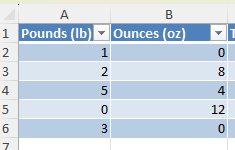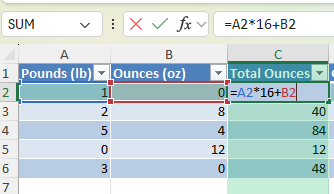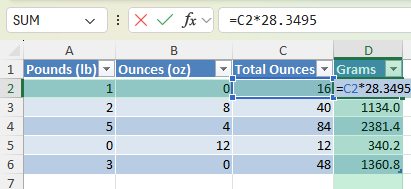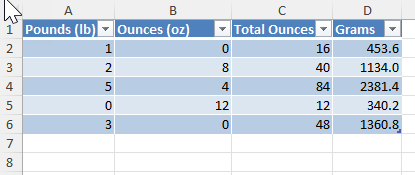Many users deal with mixed units like pounds and ounces when working with weight data. If you want to analyze or visualize this data in Excel, converting everything to a single unit like grams makes things easier. In this tutorial, we’ll walk through how to convert lb and oz to grams in Excel using simple formulas and functions.
Key Takeaways
- Use
CONVERTfor unit conversion in Excel. - Combine lb and oz into total ounces before converting.
- Grams = Ounces × 28.3495
- Helper columns simplify the process.
- You can automate the process using VBA or Power Query.
Table of Contents
Understanding LB OZ to Grams Conversion in Excel
When dealing with weight measurements, especially in industries like logistics, cooking, or manufacturing, it’s common to encounter imperial units like pounds (lb) and ounces (oz). However, many global applications require these measurements in grams (g), part of the metric system. This is where Excel becomes a handy tool.
What Does 1 LB and 1 OZ Equal in Grams?
-
1 pound (lb) = 16 ounces (oz)
-
1 ounce (oz) = 28.3495 grams
-
Therefore, 1 lb = 453.592 grams
Why Use Excel for This Conversion?
Excel allows you to automate repetitive conversions across large datasets without using external tools. By combining formulas like =CONVERT() or basic math (=lbs*453.592 + oz*28.3495), you can quickly:
-
Convert multiple rows of weight entries to grams
-
Build templates for suppliers, inventory management, or recipe adjustments
-
Avoid manual errors from calculators or hand conversion
Typical Use Cases:
-
E-commerce product sheets needing metric weight columns
-
Inventory systems importing or exporting international goods
-
Diet/nutrition tracking where metric units are required
-
Manufacturing BOMs (Bills of Materials) when parts are weighed
By structuring the worksheet with helper columns and applying the correct formula logic, Excel becomes a reliable, repeatable method for managing unit conversions at scale.
Step-by-Step Instructions
Step 1: Set Up Your Data
Start with two columns: one for pounds and one for ounces.
Step 2: Combine Pounds and Ounces into Total Ounces
In column C, use this formula:
=A2*16 + B2
This multiplies pounds by 16 (1 lb = 16 oz) and adds the remaining ounces.
Step 3: Convert Total Ounces to Grams
In column D, use this formula:
=C2 * 28.3495
This converts total ounces to grams using the standard factor.
Common Mistakes and Tips
- Wrong conversion factor: Ensure you are using 28.3495 for oz to grams.
- Forgetting to convert lbs to oz first: Always convert lb to oz before converting to grams.
- Decimal input confusion: If data is in decimal lbs (e.g. 2.5 lb), convert directly using
=A2 * 453.592. - Data entry errors: Double-check for missing or incorrect values.
- Negative or invalid values: Use
=IF(A2<0, "", ...)to ignore them.
Bonus Tips and Advanced Scenarios
1. Handle Decimal Pounds Directly
If your weight is in decimal pounds (e.g. 1.75 lb), use:
=A2 * 453.592
2. Use Power Query to Automate
Load your table into Power Query.
Add a custom column: [Pounds] * 16 + [Ounces].
Add another custom column: [TotalOunces] * 28.3495.
Load back into Excel.
3. VBA Macro to Automate the Process
Sub ConvertLbOzToGrams()
Dim ws As Worksheet
Set ws = ActiveSheet
Dim i As Integer
For i = 2 To ws.Cells(ws.Rows.Count, 1).End(xlUp).Row
Dim lb As Double
Dim oz As Double
lb = ws.Cells(i, 1).Value
oz = ws.Cells(i, 2).Value
ws.Cells(i, 3).Value = lb * 16 + oz
ws.Cells(i, 4).Value = ws.Cells(i, 3).Value * 28.3495
Next i
End Sub
Use Cases for Converting LB and OZ to Grams in Excel
Understanding why and when to convert pounds and ounces to grams in Excel can help streamline your workflows and ensure accurate data reporting. Here are several practical scenarios where this conversion proves valuable:
- Product Inventory Management: Businesses that manage inventory across global markets often need to convert product weights from imperial to metric units to comply with international labeling standards.
- Shipping and Logistics: Carriers and shipping platforms typically require weight inputs in kilograms or grams. Converting weights directly in Excel allows for easy calculation of shipping costs based on accurate mass data.
- Recipe Standardization: Food service providers and recipe creators converting traditional recipes to metric units for global publication can use Excel to automate bulk conversions of ingredient weights.
- Scientific Data Collection: Research labs or field data collectors may receive measurements in pounds and ounces and later convert them into grams for analysis, especially in health, nutrition, and environmental studies.
- eCommerce Product Listings: Sellers on platforms that require metric units (like Amazon in Europe) can use Excel to quickly convert existing product data into grams for accurate listings.
Whether you’re a small business owner, supply chain analyst, or recipe blogger, these conversions help maintain accuracy and consistency across data sets.
FAQs
1. What is the formula to convert lb and oz to grams?
= (lb * 16 + oz) * 28.3495
2. What if I only have decimal pounds?
Use =lb * 453.592 directly.
3. Can I use the CONVERT function?
Yes, but CONVERT does not support lb and oz together. Use helper columns.
4. What does 1 lb equal in grams?
1 lb = 453.592 grams
5. Can Power Query handle this automatically?
Yes, with custom columns to calculate total ounces and grams.
Summary
Whether you’re tracking shipping weights, food measurements, or packaging data, Excel makes it easy to convert pounds and ounces into grams. By setting up helper columns and using the correct formulas, you can automate the process and reduce manual errors. And with options like Power Query and VBA, you can go even further for large datasets or recurring workflows.
John Michaloudis is a former accountant and finance analyst at General Electric, a Microsoft MVP since 2020, an Amazon #1 bestselling author of 4 Microsoft Excel books and teacher of Microsoft Excel & Office over at his flagship MyExcelOnline Academy Online Course.











